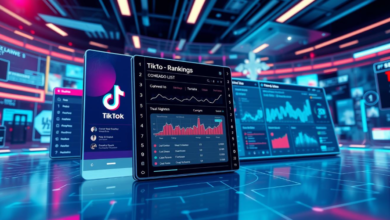B2B Programmatic Advertising Strategies for Scalable Growth

In the fast-evolving world of business-to-business (B2B) marketing, programmatic advertising has become a cornerstone for achieving scalable growth. By automating the process of buying and placing digital ads, programmatic advertising leverages data and technology to deliver highly targeted campaigns to decision-makers with precision and efficiency. Unlike traditional advertising, which often relies on manual processes and broad reach, programmatic strategies enable B2B marketers to optimize budgets, personalize messaging, and expand campaigns seamlessly. This article explores key strategies for harnessing B2B programmatic advertising to drive sustainable, scalable growth in a competitive digital landscape.
Leveraging Data-Driven Audience Segmentation
The foundation of any successful B2B programmatic advertising strategy lies in precise audience segmentation. B2B buyers, typically executives or department heads, require tailored messaging that addresses specific organizational challenges. Programmatic platforms use rich data sets—drawn from CRM systems, third-party providers, and behavioral tracking—to segment audiences based on factors like job role, industry, company size, or purchase intent.For instance, a company selling enterprise HR software might segment its audience to target HR directors at companies with over 1,000 employees who have recently engaged with content about payroll automation. By focusing on these high-value segments, marketers ensure ads reach decision-makers most likely to convert, maximizing campaign impact. Regularly refining these segments based on performance data ensures campaigns remain relevant as audience needs evolve, supporting long-term scalability.
See also: Building Financial Resilience in Corporate Finance 3714485180
Optimizing Campaigns with Real-Time Bidding
Real-time bidding (RTB) is a core component of programmatic advertising, enabling marketers to bid on ad impressions in milliseconds based on audience data. This dynamic process allows B2B marketers to optimize campaigns in real time, allocating budgets to the most effective channels and audiences. RTB ensures ads are displayed on platforms where prospects are active, such as industry websites or professional networks like LinkedIn.For example, a cybersecurity firm targeting IT managers might use RTB to place ads on tech-focused publications when its audience is online, adjusting bids based on engagement metrics like click-through rates. This flexibility minimizes wasted spend and enhances ROI, allowing businesses to scale campaigns efficiently without overextending budgets. By continuously monitoring and adjusting bids, marketers can adapt to market shifts, ensuring sustained growth.
Integrating Account-Based Marketing for Precision
Account-based marketing (ABM) is a powerful B2B strategy that focuses on high-value accounts, and programmatic advertising amplifies its effectiveness. By integrating ABM with programmatic platforms, marketers can deliver hyper-targeted ads to specific companies or decision-makers, aligning messaging with their unique needs. This approach is particularly effective for businesses targeting large enterprises with complex decision-making processes.Consider a logistics software provider aiming to win a contract with a major retailer. Using programmatic ABM, the provider could serve tailored ads to the retailer’s supply chain managers, highlighting case studies on efficiency gains. These ads could appear across multiple channels, such as LinkedIn or industry blogs, reinforcing the message. This precision targeting not only drives engagement but also supports scalability by focusing resources on accounts with the highest revenue potential.
Expanding Reach Across Diverse Channels
Programmatic advertising enables B2B marketers to scale campaigns across a variety of digital channels, from display and video ads to social media and connected TV (CTV). This multi-channel approach ensures consistent brand exposure, reaching prospects at different touchpoints in their decision-making journey. Programmatic platforms centralize campaign management, allowing marketers to adjust creative assets and budgets seamlessly across channels.For instance, a consulting firm targeting manufacturing companies might run display ads on trade publications, video ads on YouTube, and sponsored posts on LinkedIn, all managed through a single demand-side platform (DSP). This integrated strategy maximizes reach while maintaining messaging coherence, enabling businesses to scale campaigns to new audiences or markets without losing focus. As new channels like CTV gain traction, programmatic advertising offers the flexibility to adapt quickly, supporting long-term growth.
Personalizing Ads for Stakeholder Engagement
B2B sales often involve multiple stakeholders—executives, managers, and end-users—each with distinct priorities. Programmatic advertising addresses this complexity through dynamic creative optimization (DCO), which tailors ad content to specific audience segments in real time. By analyzing data on job roles or interests, platforms can deliver personalized ads that resonate with each stakeholder, fostering consensus and accelerating conversions.For example, a cloud services provider might serve an ad highlighting cost savings to CFOs while showing end-users an ad focused on ease of integration. This personalization ensures relevance, increasing engagement across diverse decision-makers. By scaling personalized campaigns across large audiences, programmatic advertising drives efficient growth, maintaining impact without requiring extensive manual customization.
Ensuring Compliance with Data Privacy Standards
As data privacy regulations like GDPR and CCPA shape the digital landscape, B2B programmatic advertising must prioritize compliance to maintain trust and effectiveness. Marketers need to use transparent data practices, such as obtaining explicit consent for tracking and providing clear opt-out options. Programmatic platforms often include compliance tools, like consent management systems, to streamline adherence to regulations.For instance, a B2B marketer targeting European clients must ensure ads comply with GDPR, using anonymized data where necessary. Ethical data use not only mitigates legal risks but also builds trust with prospects, who value transparency in a market driven by long-term relationships. By embedding compliance into programmatic strategies, businesses can scale campaigns confidently across global markets.
Measuring Performance for Continuous Improvement
The scalability of programmatic advertising relies on its measurability, with real-time analytics providing insights into campaign performance. Metrics like impressions, click-through rates, cost per lead, and conversion rates help marketers assess effectiveness and identify areas for optimization. Advanced attribution models link ad interactions to sales outcomes, offering a clear picture of ROI.For example, a B2B SaaS company might track how many leads from a programmatic campaign convert into demo requests, using this data to refine targeting or ad creatives. A/B testing different ad formats—such as video versus static banners—can further enhance performance, ensuring campaigns remain effective as they scale. This data-driven approach allows businesses to iterate quickly, adapting to market dynamics and sustaining growth.
Aligning with the B2B Sales Funnel
Programmatic advertising is most effective when integrated with the B2B sales funnel, supporting prospects from awareness to purchase. In the awareness stage, ads can drive traffic to educational content, such as webinars or eBooks, building brand credibility. In the consideration stage, retargeting ads can re-engage prospects who visited a product page, encouraging them to request a demo or consultation.This alignment ensures a cohesive buyer journey. For instance, a prospect who clicks a programmatic ad on a trade publication might receive a follow-up email with a case study, reinforcing the brand’s value proposition. By syncing programmatic efforts with funnel stages, marketers create a seamless experience that drives conversions and supports scalable growth across the sales process.
Adapting to Emerging Technologies and Trends
The future of B2B programmatic advertising is shaped by emerging technologies like artificial intelligence (AI) and 5G. AI enhances targeting by predicting prospect behavior, enabling smarter ad placements, while 5G supports faster, richer ad formats like interactive video. These advancements allow marketers to create more engaging experiences, such as immersive demos for technical products, driving higher engagement.For example, a B2B tech firm might use AI to identify prospects researching cloud solutions, delivering a video ad showcasing real-time analytics capabilities. As new platforms like CTV and audio advertising grow, programmatic strategies can adapt to reach audiences in innovative ways, ensuring scalability in an evolving digital landscape.
Building a Scalable Future for B2B Marketing
B2B programmatic advertising offers a powerful framework for achieving scalable growth, combining precision, efficiency, and adaptability. By leveraging data-driven segmentation, real-time optimization, and multi-channel reach, marketers can engage high-value audiences with tailored messaging. Integrating ABM, ensuring compliance, and aligning with the sales funnel further enhance its impact, while emerging technologies open new possibilities for innovation. As businesses navigate the complexities of B2B marketing, programmatic advertising provides the tools to drive measurable results, foster relationships, and achieve sustainable growth in a competitive market.
